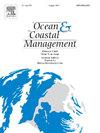Spatiotemporal evolution of typical silt-muddy coastlines and tidal flats and their response to human activities: A case study of the Yancheng Coast, China
IF 5.4
2区 环境科学与生态学
Q1 OCEANOGRAPHY
引用次数: 0
Abstract
In response to the research gaps regarding the response mechanisms of muddy coasts to human activities, this study focuses on the Yancheng coastal zone, a typical muddy coast in China, to quantify the spatiotemporal evolution patterns of the coastline and tidal flats and reveal their feedback mechanisms with human activities, thereby providing decision-making support for the sustainable development of coastal zones. Based on eight periods of Landsat remote sensing images (totaling 16 scenes) from 1990 to 2024, this study extracted instantaneous waterlines using the Normalized Difference Water Index (NDWI) and Canny edge detection, determined the coastline through tidal level interpolation discretization and visual interpretation, calculated coastline change rates using the Digital Shoreline Analysis System (DSAS), constructed the Human Activity Intensity of Land Surface (HAILS) index, and employed Redundancy Analysis (RDA) to analyze the relationship between human activities and coastal changes. The results indicate: (1) Over the 34-year period, the total length of the Yancheng coastline increased from 333.09 km to 339.89 km, with the proportion of artificial coastline rising from 12.03 % to 48.11 %. The Sheyang River serves as a boundary, with the coastline changes adhering to the “southern accretion and northern erosion” pattern, where the maximum erosion rate reached 33.7 m/a and the maximum accretion rate was 380 m/a. Tidal flat area changes exhibited a “southern decrease and northern increase” trend. (2) The intensity of human activities in the coastal area increased from 0.16 % to 0.22 %, with the equivalent area of construction land expanding by 270.46 km2, where the growth of construction land and aquaculture ponds was most significant, while the reduction in tidal flat area was most pronounced. (3) There exists a positive synergistic enhancement between coastline change intensity, artificialization index, and human activity intensity, whereas tidal flat area shows a significant negative response to human activity intensity. The “southern accretion and northern erosion” pattern in the Yancheng coastal zone results from the interaction between human activities and natural processes. This study provides new research perspectives on balancing the appropriateness of reclamation, coastline stability, and coastal ecosystem diversity in typical muddy coasts.
典型粉砂质淤泥质海岸线和潮滩的时空演变及其对人类活动的响应——以盐城海岸为例
针对泥质海岸对人类活动响应机制的研究空白,本研究以中国典型泥质海岸盐城海岸带为研究对象,量化海岸线和滩带的时空演变格局,揭示其与人类活动的反馈机制,为海岸带的可持续发展提供决策支持。基于1990 - 2024年8期Landsat遥感影像(共16个场景),利用归一化差水指数(NDWI)和Canny边缘检测提取瞬时水线,通过潮位插值离散化和目视解译确定海岸线,利用数字海岸线分析系统(DSAS)计算海岸线变化率,构建地表人类活动强度(HAILS)指数。利用冗余分析(RDA)分析人类活动与海岸带变化的关系。结果表明:①34 a期间,盐城海岸线总长度从333.09 km增加到339.89 km,人工海岸线占比从12.03%增加到48.11%;以射阳河为界,海岸线变化遵循“南冲北蚀”的格局,最大侵蚀速率达到33.7 m/a,最大侵蚀速率为380 m/a。滩涂面积变化呈现“南减北增”的趋势。②沿海地区人类活动强度从0.16%增加到0.22%,建设用地等效面积增加270.46 km2,其中建设用地和养殖池塘面积增长最为显著,滩带面积减少最为明显;(3)海岸线变化强度、人工化指数与人类活动强度之间存在正向的协同增强关系,滩涂面积对人类活动强度呈显著的负响应关系。盐城海岸带的“南积北蚀”格局是人类活动与自然过程相互作用的结果。本研究为典型泥质海岸填海适宜性、海岸线稳定性和海岸生态系统多样性的平衡提供了新的研究视角。
本文章由计算机程序翻译,如有差异,请以英文原文为准。
求助全文
约1分钟内获得全文
求助全文
来源期刊

Ocean & Coastal Management
环境科学-海洋学
CiteScore
8.50
自引率
15.20%
发文量
321
审稿时长
60 days
期刊介绍:
Ocean & Coastal Management is the leading international journal dedicated to the study of all aspects of ocean and coastal management from the global to local levels.
We publish rigorously peer-reviewed manuscripts from all disciplines, and inter-/trans-disciplinary and co-designed research, but all submissions must make clear the relevance to management and/or governance issues relevant to the sustainable development and conservation of oceans and coasts.
Comparative studies (from sub-national to trans-national cases, and other management / policy arenas) are encouraged, as are studies that critically assess current management practices and governance approaches. Submissions involving robust analysis, development of theory, and improvement of management practice are especially welcome.
 求助内容:
求助内容: 应助结果提醒方式:
应助结果提醒方式:


